Remotely Powered Two-Wire Cooperative Sensors for Bioimpedance Imaging Wearables
Abstract
1. Introduction
2. State of the Art in Cooperative Sensors
2.1. Basic Circuits and Their Interconnections
2.2. Floating Supply, Bootstrapping, Current Source, and Current/Potential Wire Separation
3. Methods
3.1. Previous Approach Using Off-the-Shelf Components and Powering at 500 Hz
3.2. The Approach Addressing the Safety Issue with Powering at 1 MHz and ASIC
3.3. Comparison to Existing Work
4. Results
4.1. Legacy Approach with 500 Hz Powering and Off-the-Shelf Components
4.1.1. WELMO Vest
4.1.2. Calibration
4.2. Addressing Safety with Powering at 1 MHz and an ASIC Implementation
4.2.1. ASIC Architecture
4.2.2. The Architecture of the Central Unit
4.2.3. Sensor Housings
4.2.4. Implementation Results
5. Conclusions
6. Patents
Author Contributions
Funding
Data Availability Statement
Conflicts of Interest
Appendix A
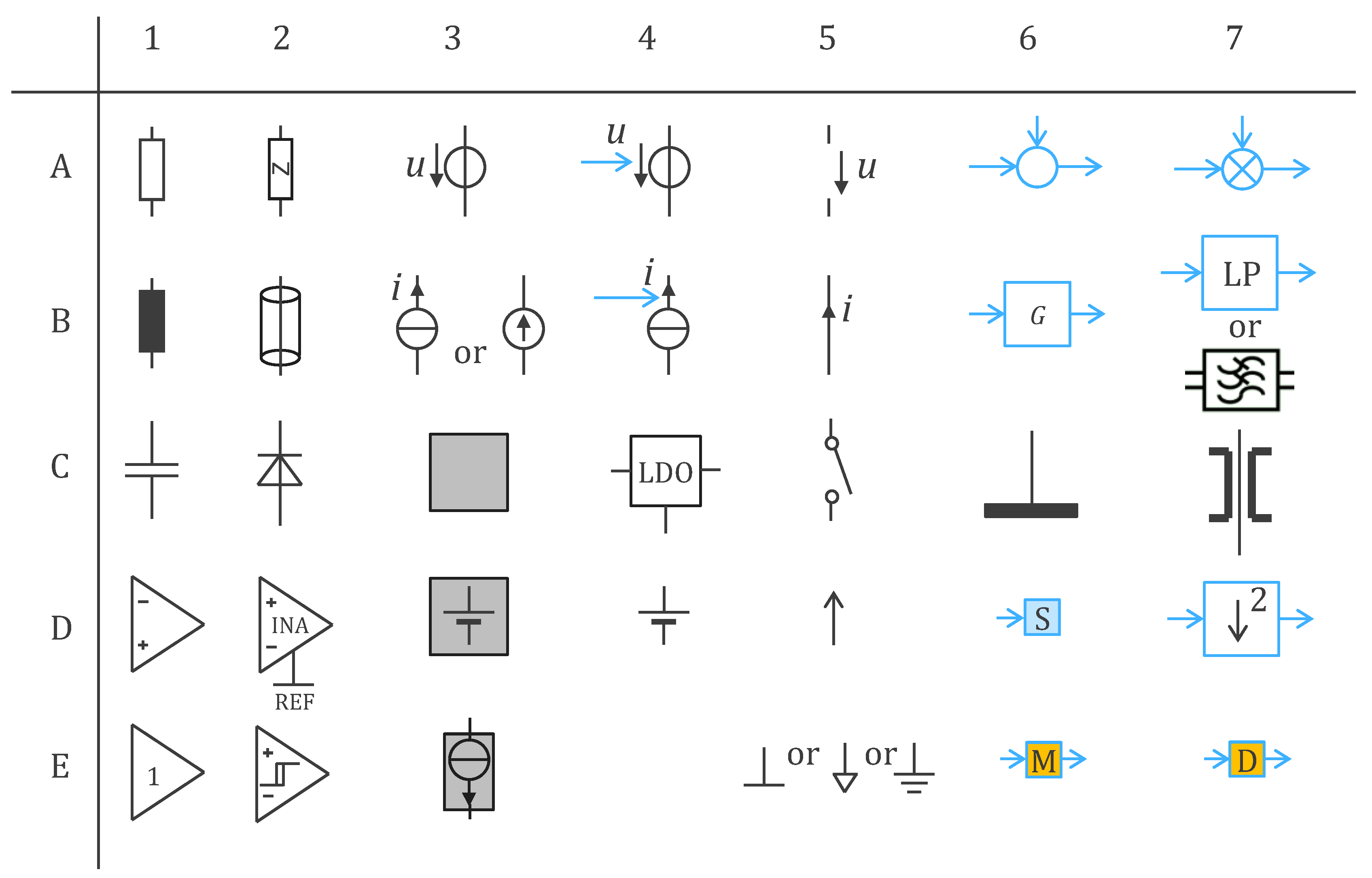
References
- Adler, A.; Holder, D. (Eds.) Electrical Impedance Tomography—Methods, History and Applications, 2nd ed.; CRC Press: Boca Raton, FL, USA, 2022; ISBN 9780367023782. [Google Scholar]
- Yang, J. The Investigation and Implementation of Electrical Impedance Tomography Hardware System. Ph.D. Thesis, De Montfort University, Leicester, UK, 2006. [Google Scholar]
- Lee, M.H.; Jang, G.Y.; Kim, Y.E.; Yoo, P.J.; Wi, H.; Oh, T.I.; Woo, E.J. Portable multi-parameter electrical impedance tomography for sleep apnea and hypoventilation monitoring: Feasibility study. Physiol. Meas. 2018, 39, 124004. [Google Scholar] [CrossRef] [PubMed]
- Gaggero, P.O. Miniaturization and Distinguishability Limits of Electrical Impedance Tomography for Biomedical Application. Ph.D. Thesis, Université de Neuchâtel, Neuchâtel, Switzerland, 2011. [Google Scholar] [CrossRef]
- Qin, S.; Yao, Y.; Xu, Y.; Xu, D.; Gao, Y.; Xing, S.; Li, Z. Characteristics and topic trends on electrical impedance tomography hardware publications. Front. Physiol. 2022, 13, 1011941. [Google Scholar] [CrossRef] [PubMed]
- Mosquera, V.; Rengifo, C. Electrical Impedance Tomography: Hardware Fundamentals and Medical Applications. Ing. Solidar. 2020, 16, 1–29. [Google Scholar] [CrossRef]
- Kim, M.; Bae, J.; Yoo, H.-J. Wearable 3D lung ventilation monitoring system with multi frequency electrical impedance tomography. In Proceedings of the 2017 IEEE Biomedical Circuits and Systems Conference (BioCAS), Turin, Italy, 19–21 October 2017; pp. 1–4. [Google Scholar] [CrossRef]
- Proença, M.; Braun, F.; Lemay, M.; Solà, J.; Adler, A.; Riedel, T.; Messerli, F.H.; Thiran, J.-P.; Rimoldi, S.F.; Rexhaj, E. Non-invasive pulmonary artery pressure estimation by electrical impedance tomography in a controlled hypoxemia study in healthy subjects. Sci. Rep. 2020, 10, 21462. [Google Scholar] [CrossRef] [PubMed]
- Webster, J.G.; Clark, J.W. (Eds.) Medical Instrumentation: Application and Design, 4th ed.; John Wiley & Sons: Hoboken, NJ, USA, 2010. [Google Scholar]
- IEC 60601-1; Medical Electrical Equipment—Part 1: General Requirements for Basic Safety and Essential Performance. IEC: Geneva, Switzerland, 2020.
- Chételat, O. Synchronization and Communication Bus for Biopotential and Bioimpedance Measurement Systems. EP Patent 2567657 B1, 13 March 2013. [Google Scholar]
- Chételat, O.; Correvon, M. Measurement Device for Measuring Bio-Impedance and/or a Bio-Potential of a Human or Animal Body. U.S. Patent 2015/0173677 B2, 25 June 2015. [Google Scholar]
- Rapin, M.; Proença, M.; Braun, F.; Meier, C.; Sola, J.; Ferrario, D.; Grossenbacher, O.; Porchet, J.-A.; Chételat, O. Cooperative dry-electrode sensors for multi-lead biopotential and bioimpedance monitoring. Physiol. Meas. 2015, 36, 767–783. [Google Scholar] [CrossRef] [PubMed]
- Rapin, M. A Wearable Sensor Architecture for High-Quality Measurement of Multilead ECG and Frequency-Multiplexed EIT. Ph.D. Thesis, ETH, Zürich, Switzerland, 2018. [Google Scholar] [CrossRef]
- Wade, E.; Asada, H. Cable-free wearable sensor system using a DC powerline body network in a conductive fabric vest. In Proceedings of the 26th Annual International Conference of the IEEE Engineering in Medicine and Biology Society, San Francisco, CA, USA, 1–5 September 2004; pp. 5376–5379. [Google Scholar] [CrossRef]
- Akita, J.; Shinmura, T.; Toda, M. Toda Flexible Network Infrastructure for Wearable Computing Using Conductive Fabric and Its Evaluation. In Proceedings of the 26th IEEE International Conference on Distributed Computing Systems Workshops (ICDCSW’06), Lisbon, Portugal, 4–7 July 2006; p. 65. [Google Scholar] [CrossRef]
- Noda, A.; Shinoda, H. Inter-IC for Wearables (I2We): Power and Data Transfer Over Double-Sided Conductive Textile. IEEE Trans. Biomed. Circuits Syst. 2018, 13, 80–90. [Google Scholar] [CrossRef] [PubMed]
- Zhu, Y.; Noda, A.; Fujiwara, M.; Makino, Y.; Shinoda, H. Fast half-duplex communication on e-textile based wearable networks. IEICE Commun. Express 2020, 9, 426–432. [Google Scholar] [CrossRef]
- Chételat, O.; Rapin, M.; Bonnal, B.; Fivaz, A.; Wacker, J.; Sporrer, B. Remotely Powered Two-Wire Cooperative Sensors for Biopotential Imaging Wearables. Sensors 2022, 22, 8219. [Google Scholar] [CrossRef] [PubMed]
- Chételat, O.; Solà, J. Floating Front-End Amplifier and One-Wire Measuring Device. U.S. Patent 8427181 B2, 16 September 2009. [Google Scholar]
- Chételat, O.; Gentsch, R.; Krauss, J.; Luprano, J. Getting rid of the wires and connectors in physiological monitoring. In Proceedings of the 30th Annual International Conference of the IEEE Engineering in Medicine and Biology Society, Vancouver, BC, Canada, 20–25 August 2008. [Google Scholar] [CrossRef]
- Chételat, O.; Bonnal, B.; Fivaz, A. Remotely Powered Cooperative Sensor Device. U.S. Patent 2021/0169543 A1, 10 June 2021. [Google Scholar]
- Frerichs, I.; Paradiso, R.; Kilintzis, V.; Rocha, B.M.; Braun, F.; Rapin, M.; Caldani, L.; Beredimas, N.; Trechlis, R.; Suursalu, S.; et al. Wearable pulmonary monitoring system with integrated functional lung imaging and chest sound recording: A clinical investigation in healthy subjects. Physiol. Meas. 2023, 44, 045002. [Google Scholar] [CrossRef] [PubMed]
- Rocha, B.M.; Filos, D.; Mendes, L.; Serbes, G.; Ulukaya, S.; Kahya, Y.P.; Jakovljevic, N.; Turukalo, T.L.; Vogiatzis, I.M.; Perantoni, E.; et al. An open access database for the evaluation of respiratory sound classification algorithms. Physiol. Meas. 2019, 40, 035001. [Google Scholar] [CrossRef] [PubMed]
- Frerichs, I.; Vogt, B.; Wacker, J.; Paradiso, R.; Braun, F.; Rapin, M.; Caldani, L.; Chételat, O.; Weiler, N. Multimodal remote chest monitoring system with wearable sensors: A validation study in healthy subjects. Physiol. Meas. 2020, 41, 015006. [Google Scholar] [CrossRef] [PubMed]
- Yilmaz, G.; Rapin, M.; Pessoa, D.; Rocha, B.M.; de Sousa, A.M.; Rusconi, R.; Carvalho, P.; Wacker, J.; Paiva, R.P.; Chételat, O. A Wearable Stethoscope for Long-Term Ambulatory Respiratory Health Monitoring. Sensors 2020, 20, 5124. [Google Scholar] [CrossRef] [PubMed]
- Lasarow, L.; Vogt, B.; Zhao, Z.; Balke, L.; Weiler, N.; Frerichs, I. Regional lung function measures determined by electrical impedance tomography during repetitive ventilation manoeuvres in patients with COPD. Physiol. Meas. 2021, 42, 015008. [Google Scholar] [CrossRef] [PubMed]
- Rocha, B.M.; Pessoa, D.; Marques, A.; Carvalho, P.; Paiva, R.P. Automatic Classification of Adventitious Respiratory Sounds: A (Un)Solved Problem? Sensors 2021, 21, 57. [Google Scholar] [CrossRef] [PubMed]
- Frerichs, I. EIT for Measurement of Lung Function. In Electrical Impedance Tomography: Methods, History and Applications, 2nd ed.; Adler, A., Holder, D., Eds.; CRC Press: Boca Raton, FL, USA, 2021; pp. 171–190. ISBN 978-0-7503-0952-3. [Google Scholar] [CrossRef]
- Haris, K.; Vogt, B.; Strodthoff, C.; Pessoa, D.; Cheimariotis, G.A.; Rocha, B.; Petmezas, G.; Weiler, N.; Paiva, R.P.; de Carvalho, P.; et al. Identification and analysis of stable breathing periods in electrical impedance tomography recordings. Physiol. Meas. 2021, 42, 64003. [Google Scholar] [CrossRef] [PubMed]
- Frerichs, I.; Zhao, Z.; Dai, M.; Braun, F.; Proença, M.; Rapin, M.; Wacker, J.; Lemay, M.; Haris, K.; Petmezas, G.; et al. Respiratory image analysis. In Wearable Sensing and Intelligent Data Analysis for Respiratory Management; Paiva, R.P., de Carvalho, P., Kilintzis, V., Eds.; Academic Press: Cambridge, MA, USA, 2022; pp. 169–212. ISBN 978-0-12-823447-1. [Google Scholar]
- Frerichs, I.; Vogt, B.; Weiler, N. Elektrische Impedanztomographie zur Untersuchung der regionalen Lungenfunktion. Atemwegs-Lungenkrankh. 2021, 47, 401–411. [Google Scholar] [CrossRef]
- Frerichs, I.; Lasarow, L.; Strodthoff, C.; Vogt, B.; Zhao, Z.; Weiler, N. Spatial ventilation inhomogeneity determined by electrical impedance tomography in patients with COPD. Front. Physiol. 2021, 12, 762791. [Google Scholar] [CrossRef] [PubMed]
- Pessoa, D.; Rocha, B.M.; Cheimariotis, G.A.; Haris, K.; Strodthoff, C.; Kaimakamis, E.; Maglaveras, N.; Frerichs, I.; de Carvalho, P.; Paiva, R.P. Classification of electrical impedance tomography data using machine learning. In Proceedings of the 43rd Annual International Conference of the IEEE Engineering in Medicine & Biology Society (EMBC), Mexico, 1–5 November 2021; pp. 349–353. [Google Scholar] [CrossRef]
- Paradiso, R.; Caldani, L. Textiles and Smart Materials for Wearable Monitoring Systems. In Wearable Sensing and Intelligent Data Analysis for Respiratory Management; Paiva, R.P., de Carvalho, P., Kilintzis, V., Eds.; Academic Press: Cambridge, MA, USA, 2022; pp. 169–212. ISBN 978-0-12-823447-1. [Google Scholar]
- Wacker, J.; Bonnal, B.; Braun, F.; Chételat, O.; Ferrario, D.; Lemay, M.; Rapin, M.; Renevey, P.; Yilmaz, G. Wearable Sensing and Intelligent Data Analysis for Respiratory Management; Paiva, R.P., de Carvalho, P., Kilintzis, V., Eds.; Academic Press: Cambridge, MA, USA, 2022; pp. 59–93. ISBN 978-0-12-823447-1. [Google Scholar]
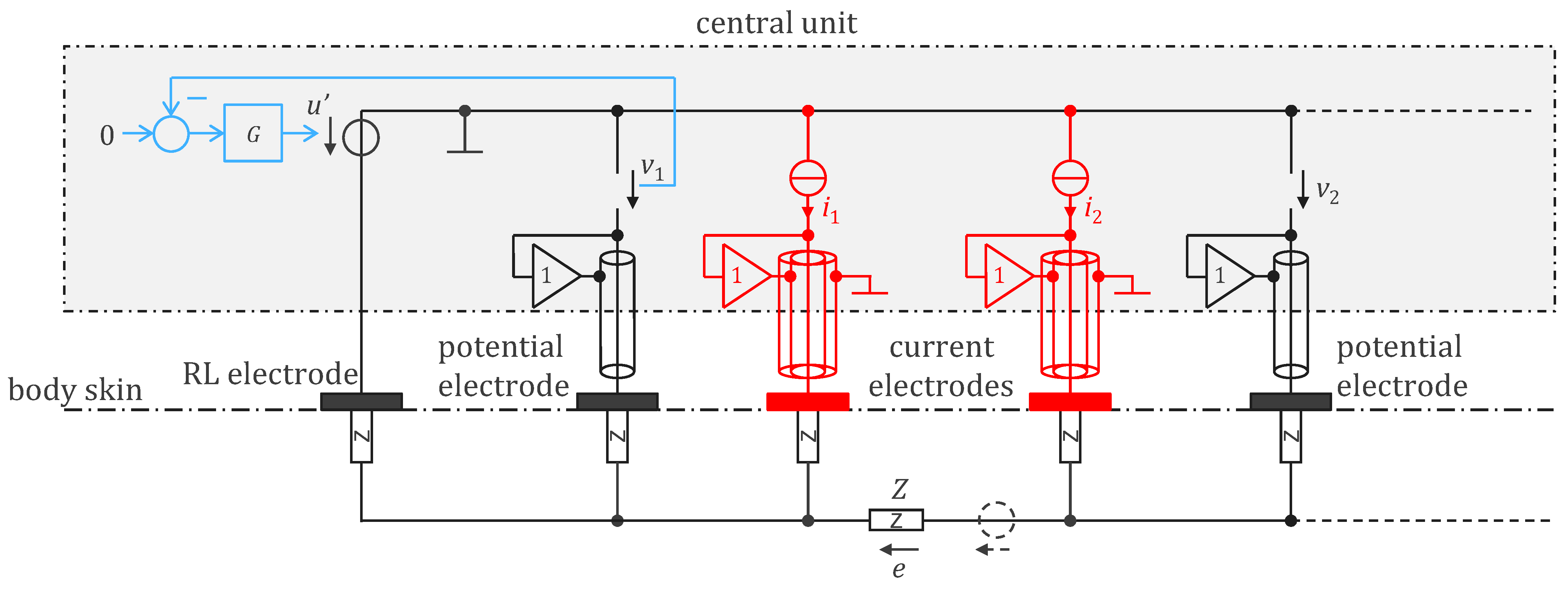

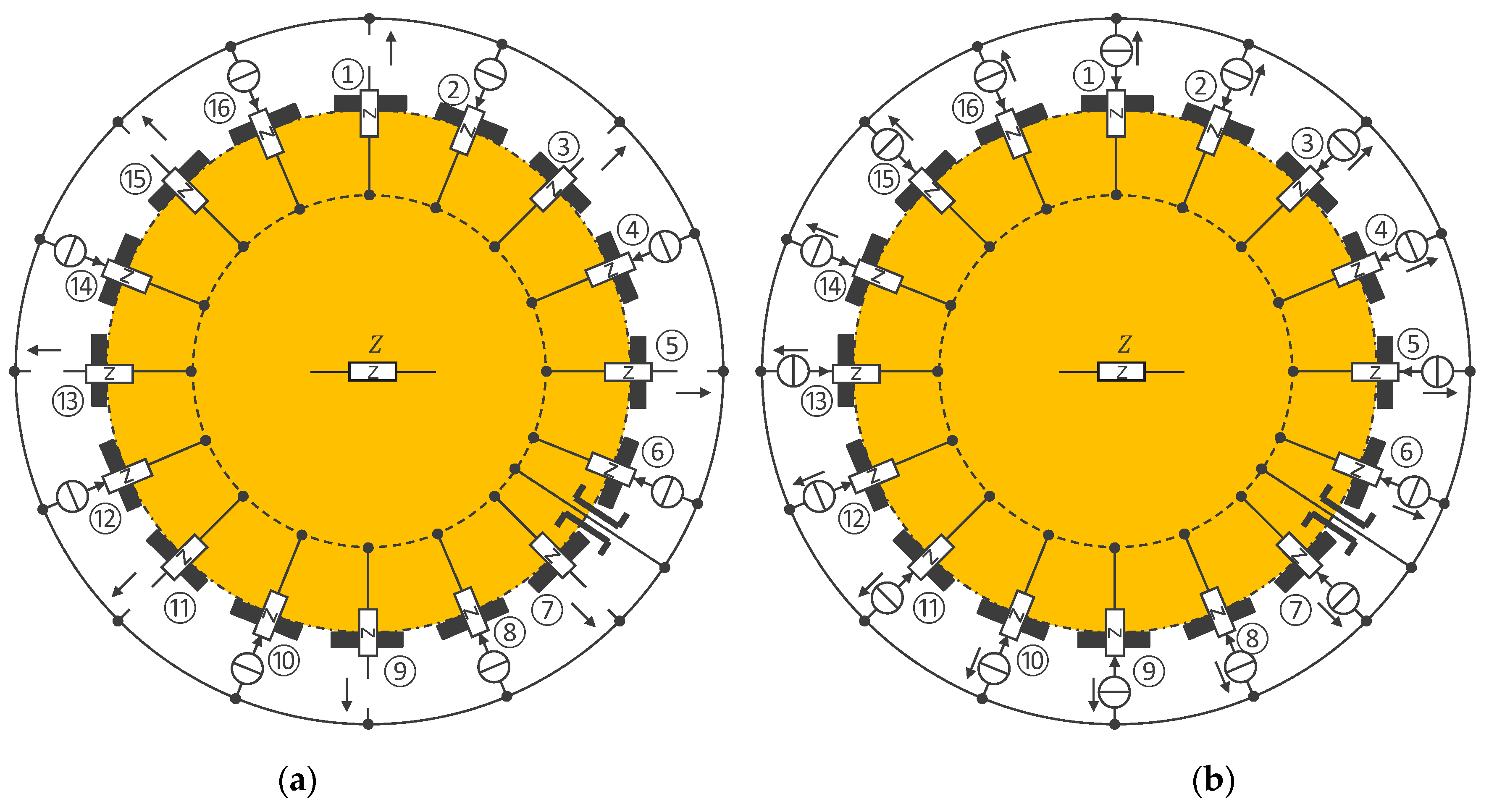


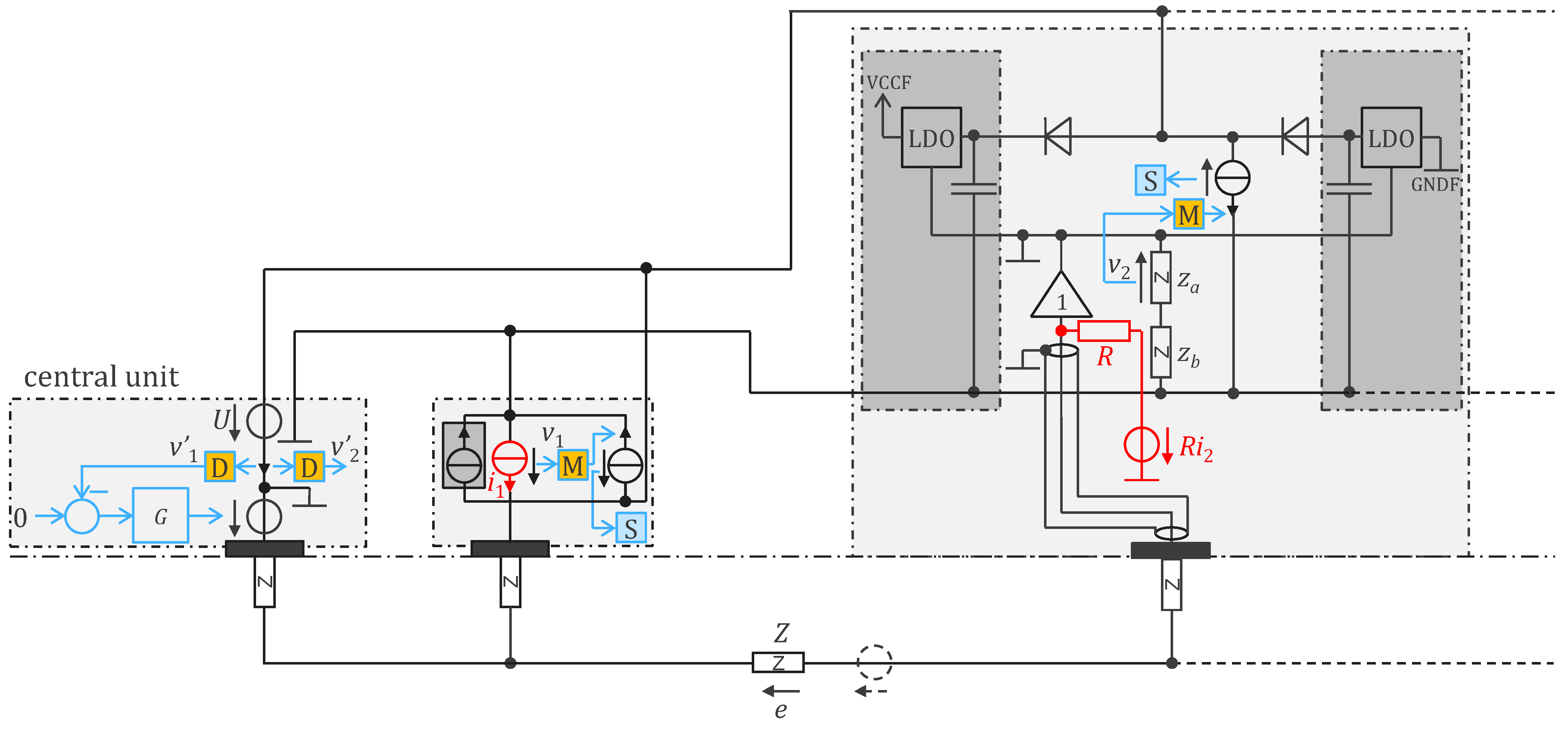

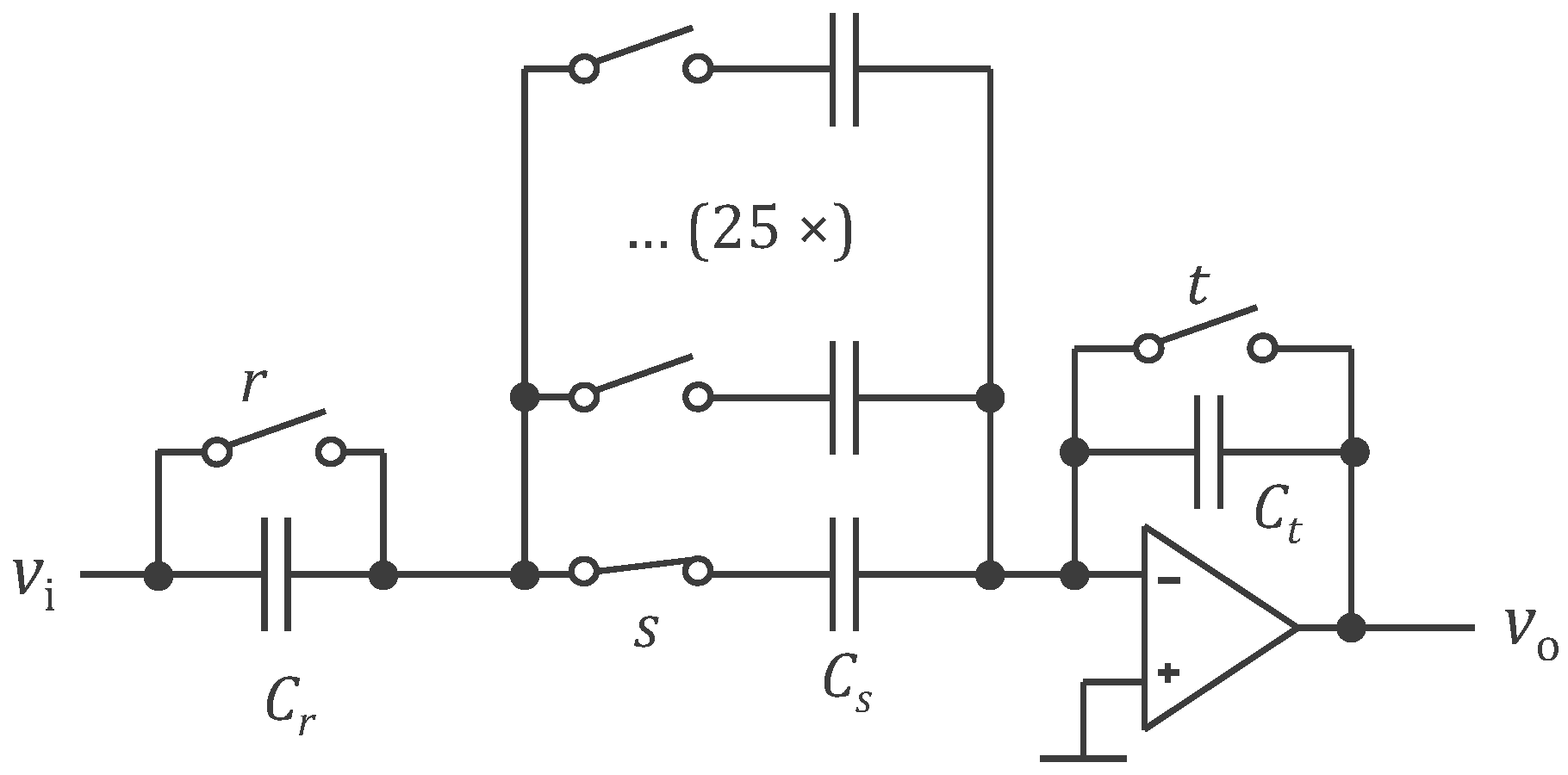

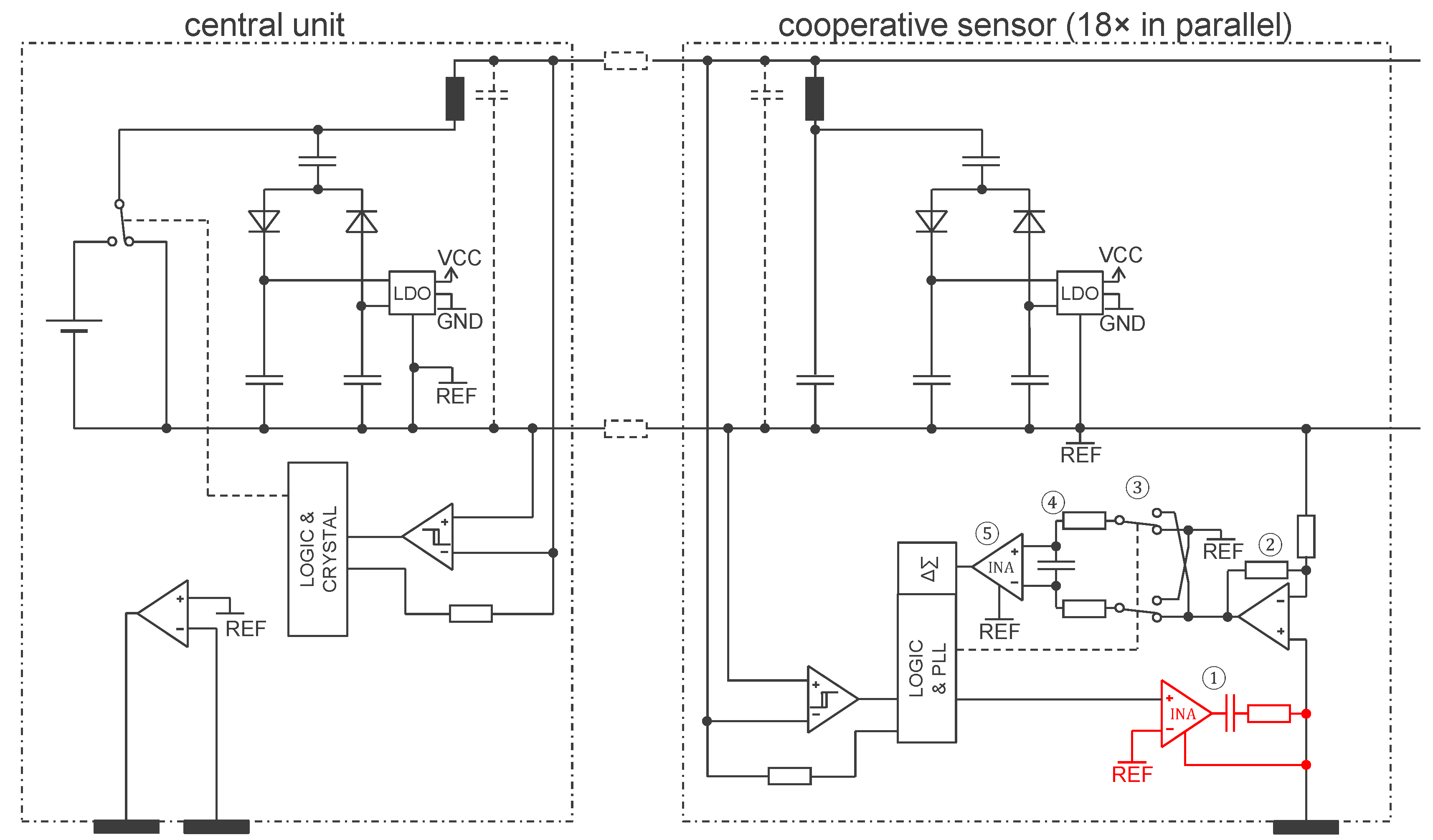
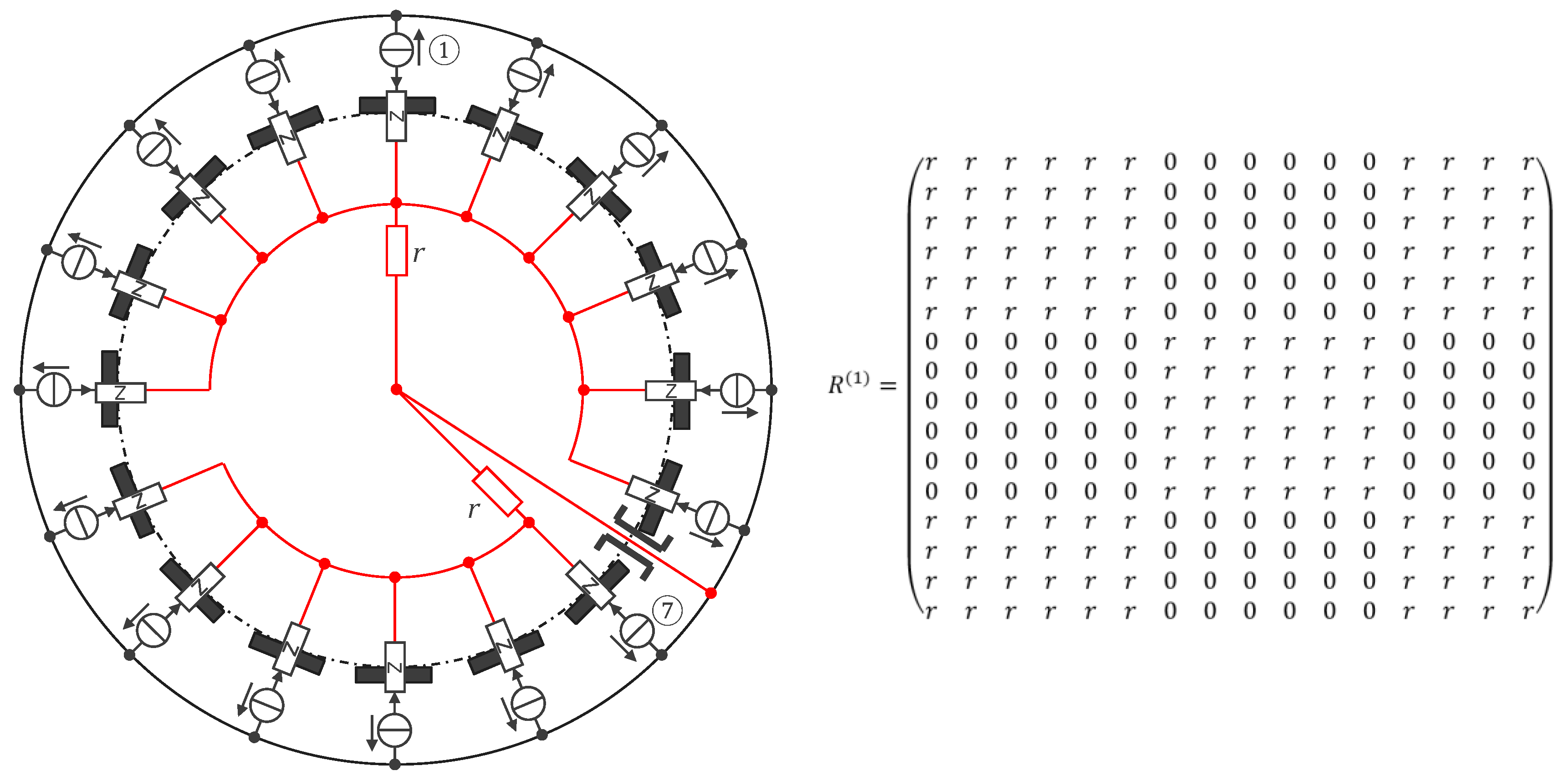
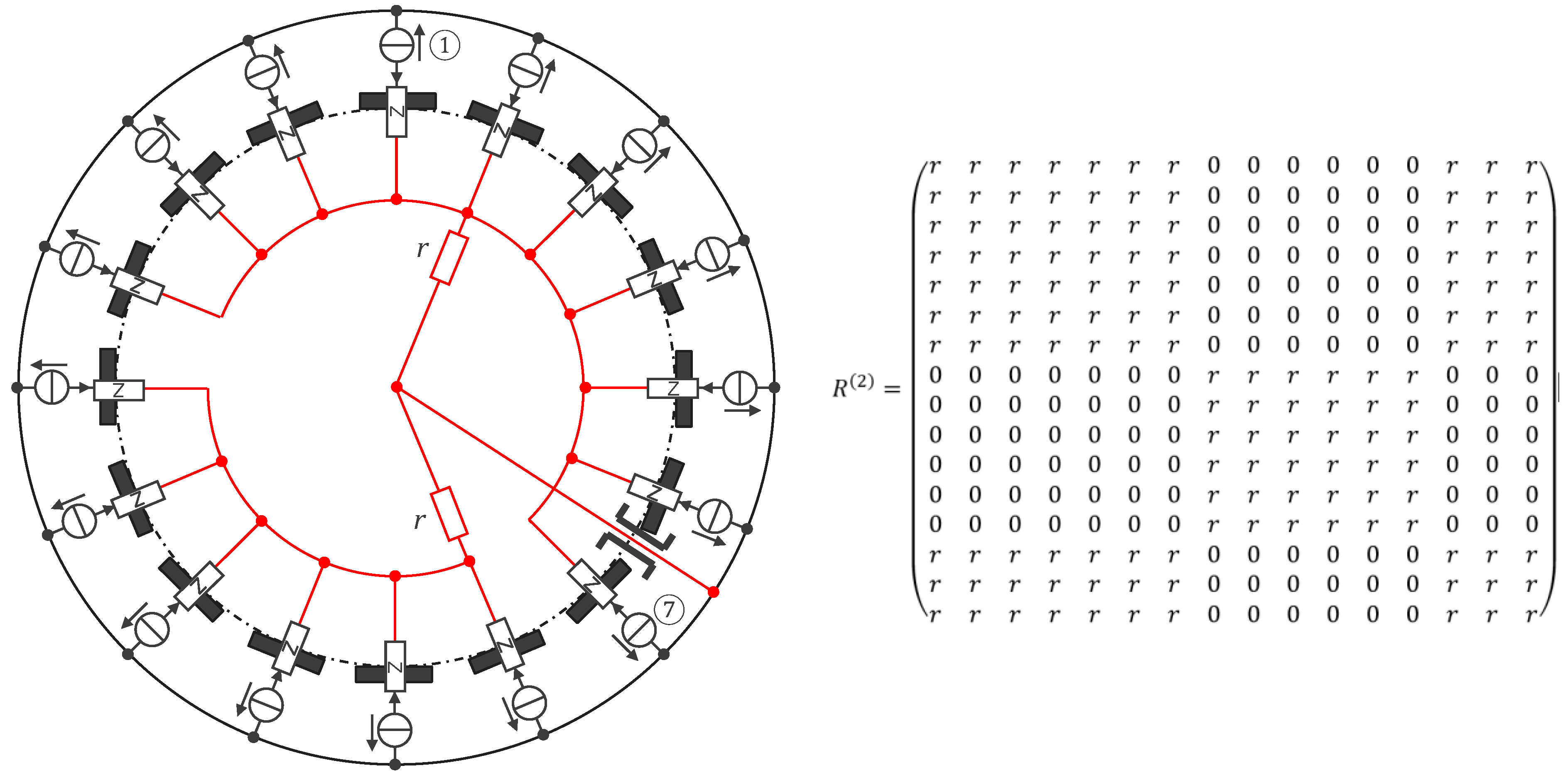
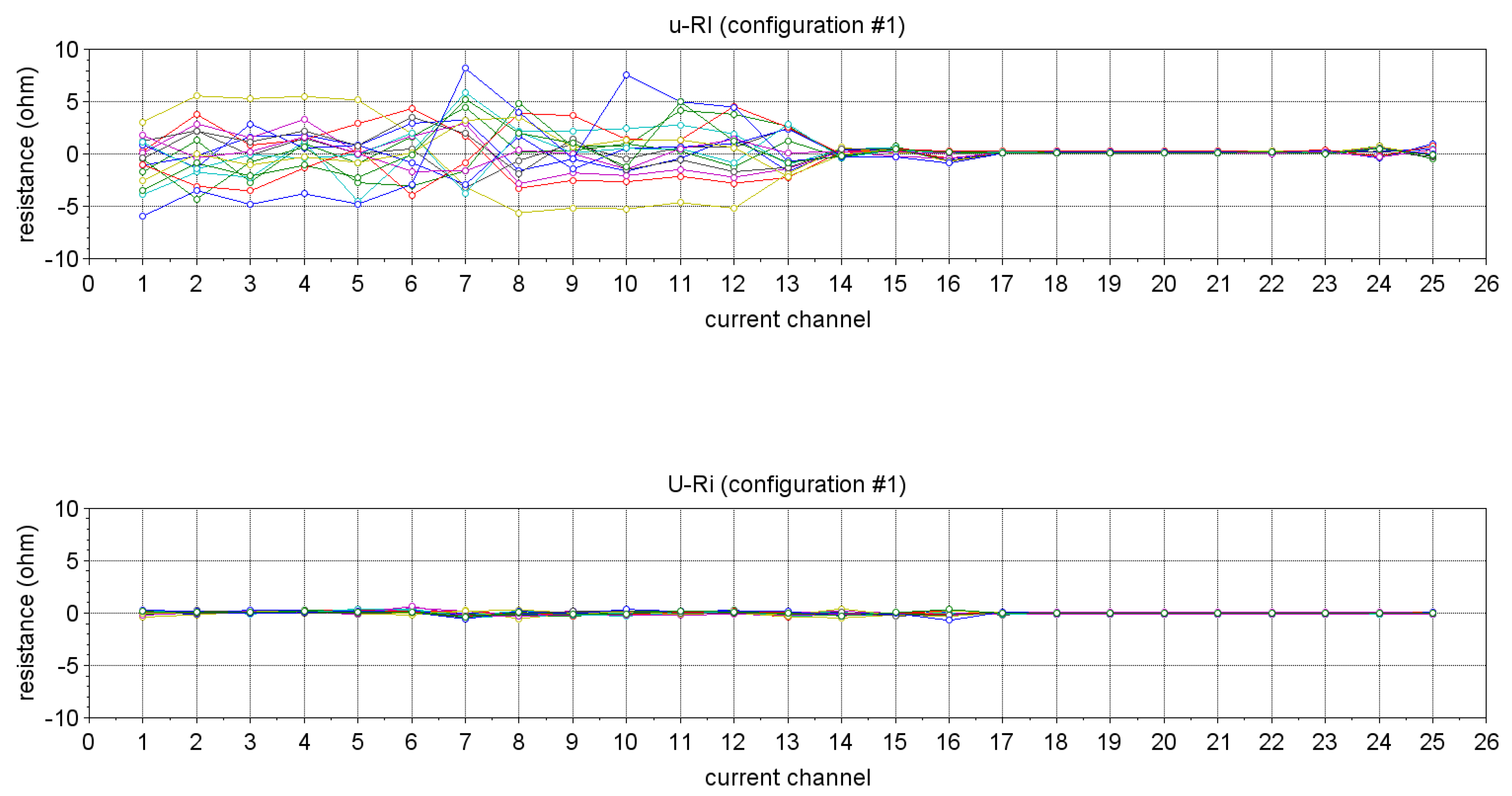
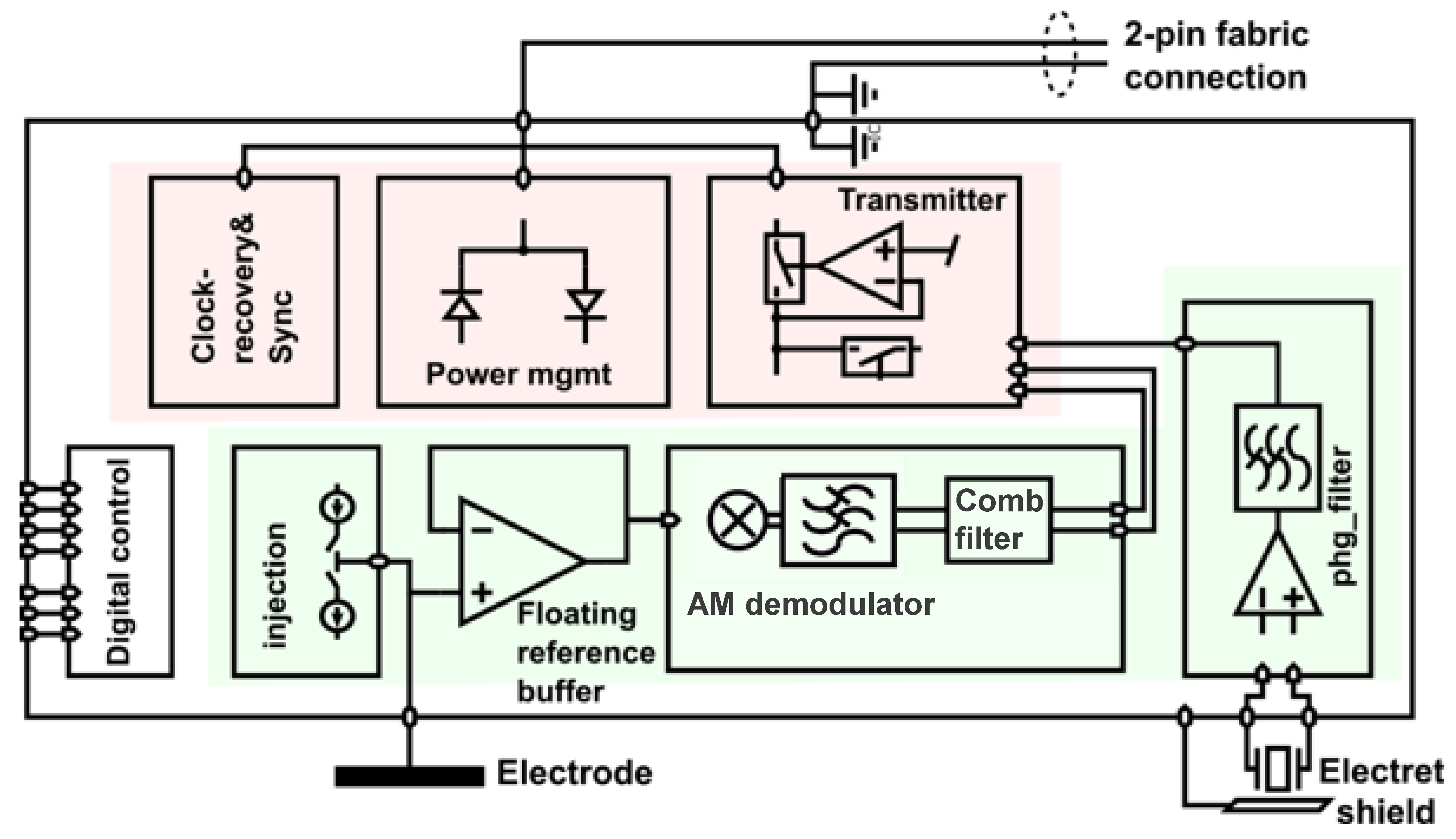

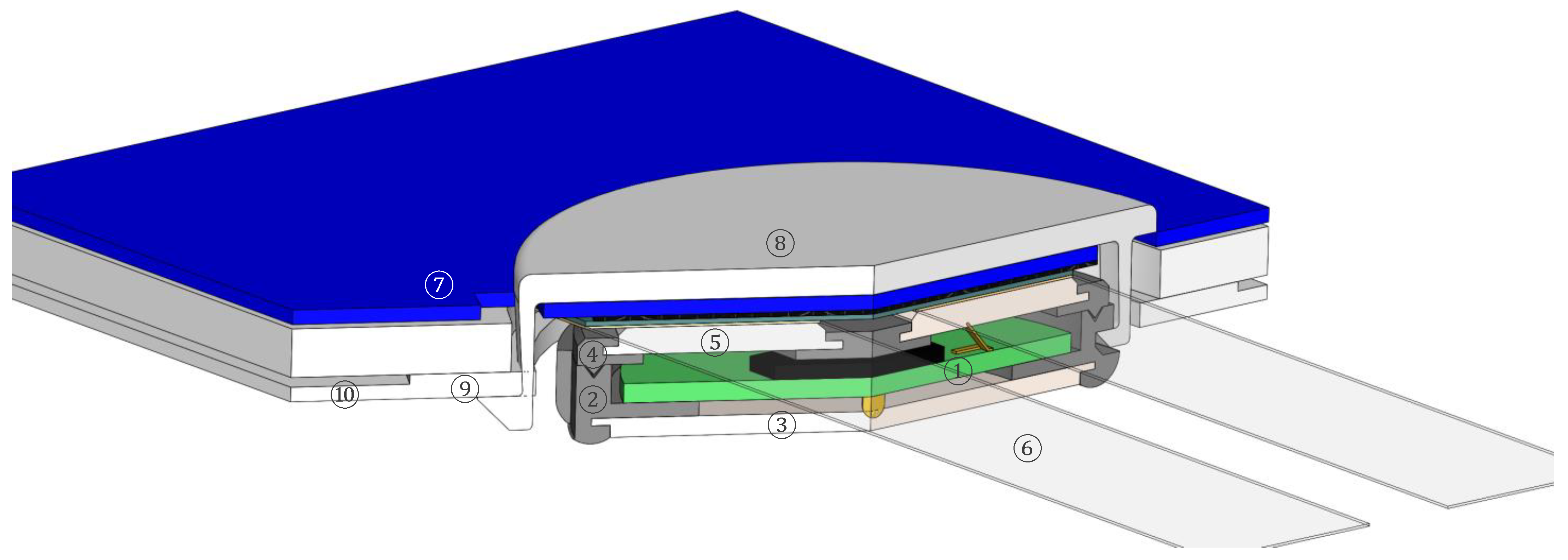
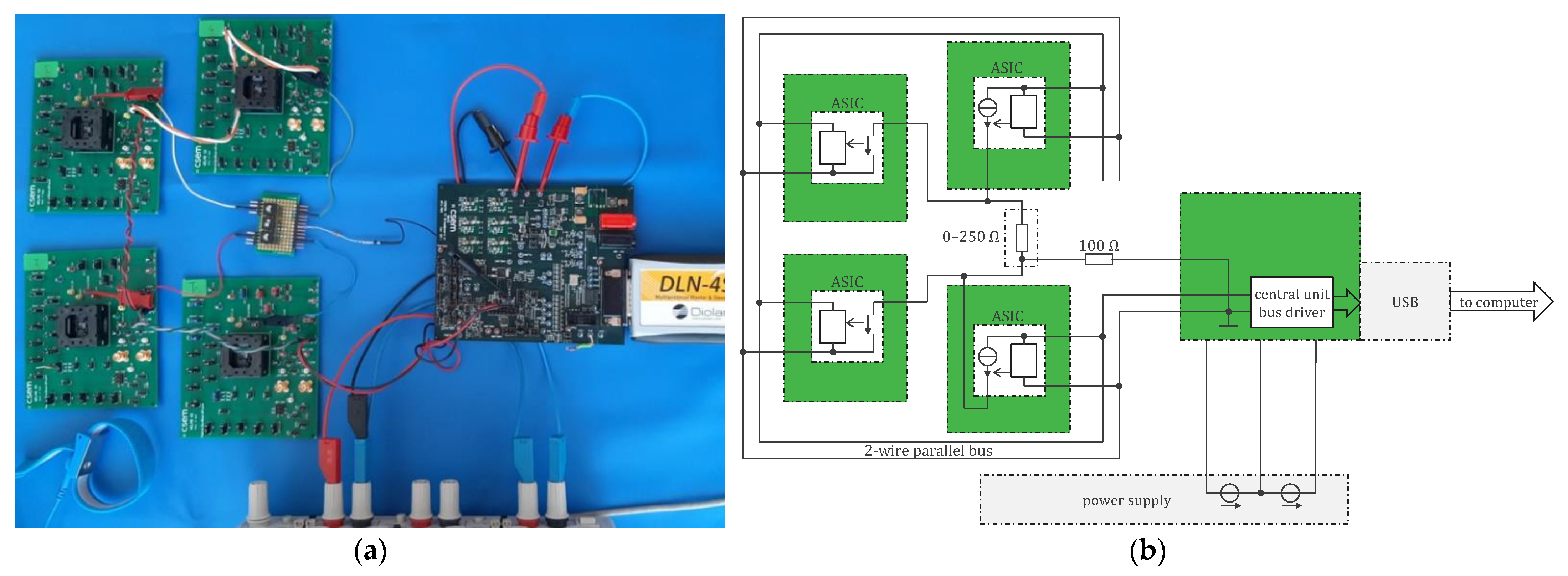
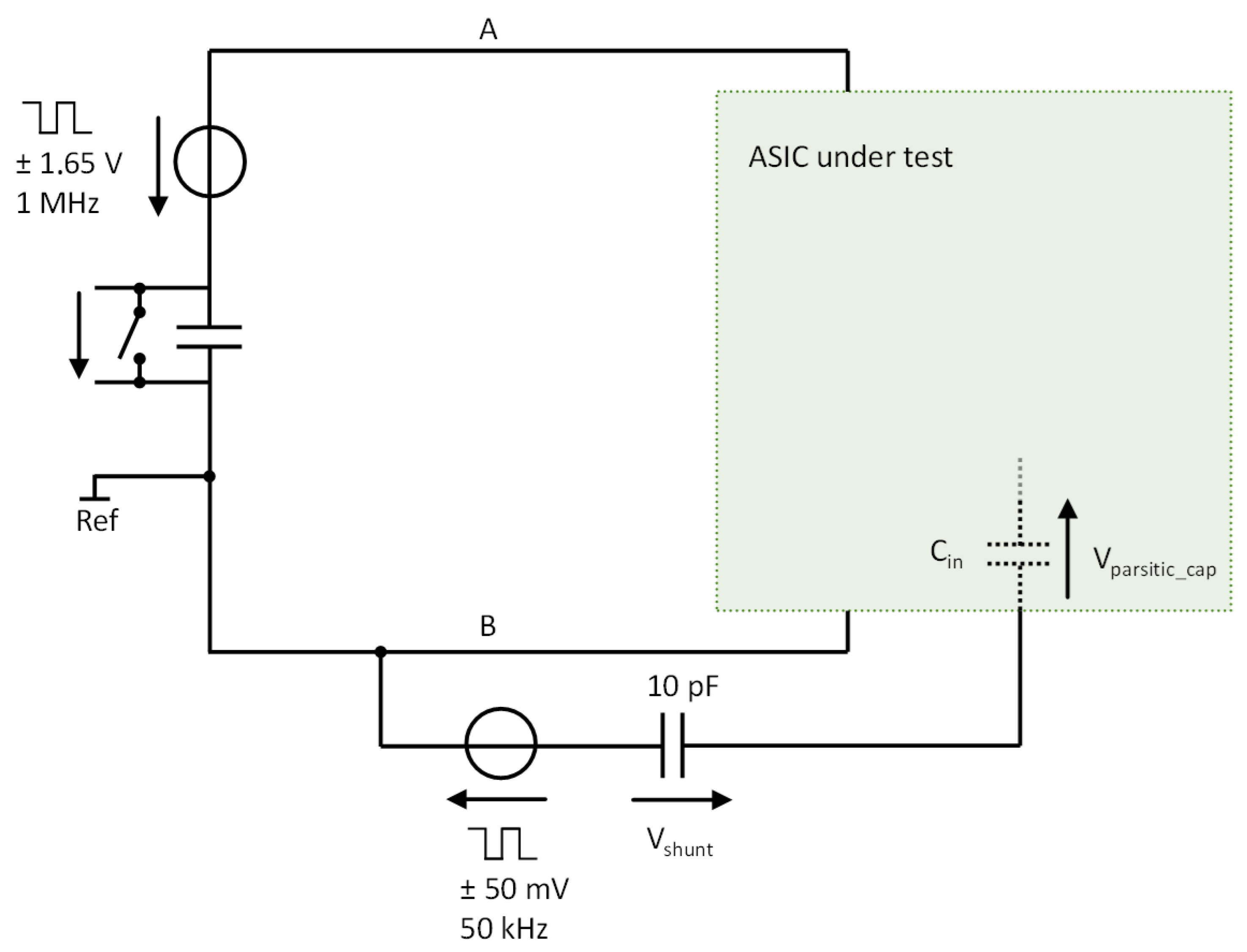
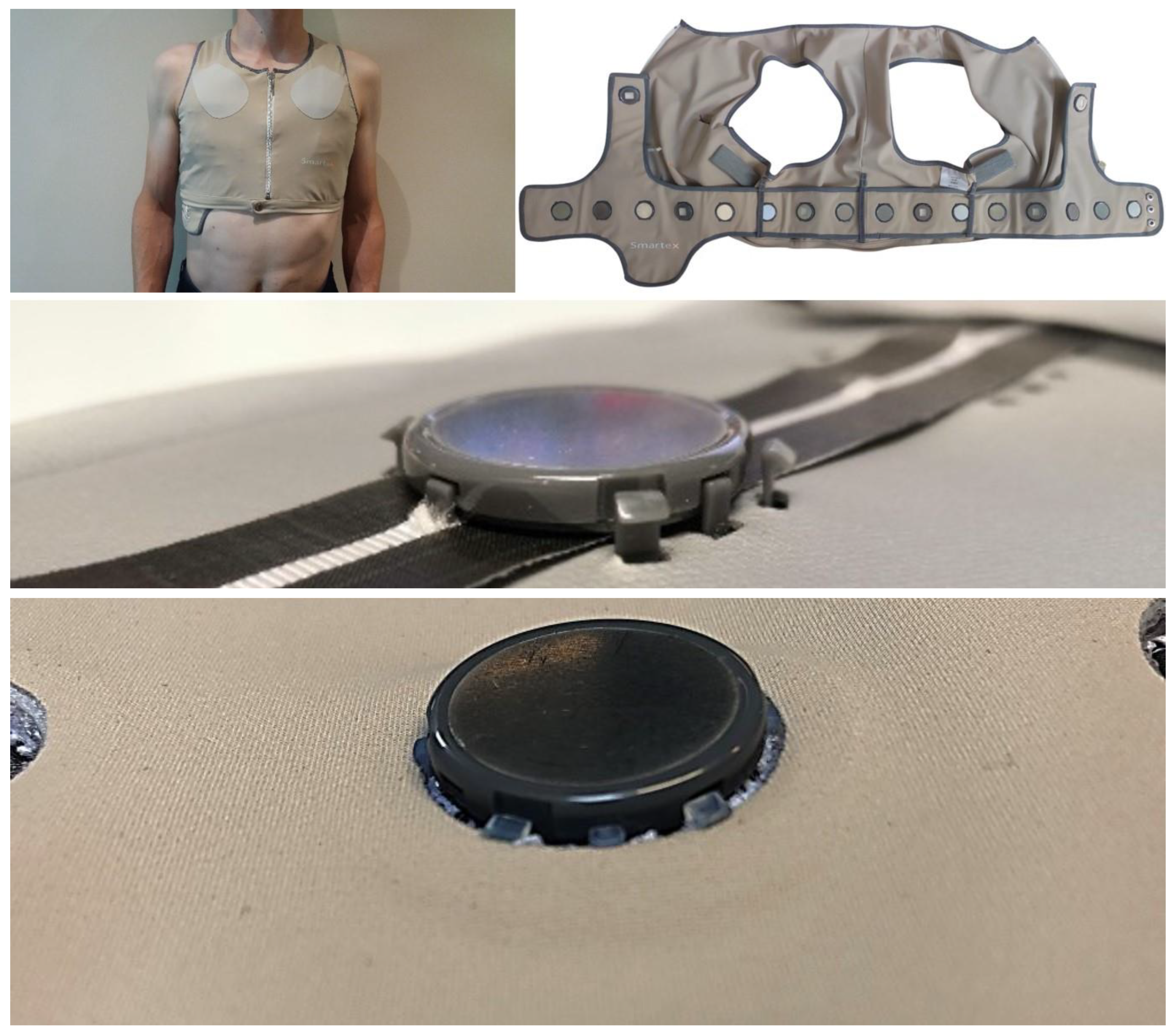
| Technique/Features | Ref. | Comment |
|---|---|---|
| Conventional star arrangement | Not suitable for wearables with many electrodes | |
| Passive electrodes, shielded cables | [1] | Widespread |
| Active electrodes, multi-wire cables | [2,3] | Well known, but not often used |
| Parallel bus arrangement | Scalable (connector size independent of nb. of electr.) | |
| Bus with more than two wires | [4] | Not easily flexible, stretchable, breathable, washable |
| Two-wire bus (cooperative sensors) | Section 2 | Simplest connection |
| Locally powered Bootstrapping Separate potential/impedance wires | Section 2.1 Section 2.2 Section 2.2 | Easy to comply with safety (medical standards) Suitable for dry electrodes, easy current source Wire impedance is not part of measured bioimpedance |
| Remotely powered (biopotential only) | [19] | |
| Remotely powered (+bioimpedance) | Section 3 and Section 4 | Sensors can be miniaturized |
| No monitoring of leakage currents No bootstrapping No separate potential/impedance wires | Section 3.1 and Section 4.1 | Requires reliable waterproof double insulation Not ideal for dry electrodes, complex current source Measured bioimpedance including wire impedance |
| Monitorable leakage currents Bootstrapping Separate potential/impedance wires | Section 3.2 and Section 4.2 | Suitably flexible, stretchable, breathable, washable Suitable for dry electrodes, high-end current source Wire impedance is not part of measured bioimpedance |
| Channel | Injected Current (100 µA rms, 40 kHz Square Wave) |
|---|---|
| 1 | ① → ⑦ |
| 2 | ② → ⑧ |
| … | … |
| 10 | ⑩ → ⑯ |
| 11 | ⑪ → ① |
| … | … |
| 16 | ⑯ → ⑥ |
| 17–25 | unused (yet) |
| R (Ω) ±0.02% | Measurement (Ω) | Linearity (% FS) | Noise in 0–2.5 Hz (mΩ rms) |
|---|---|---|---|
| 250 | 249.95 | −0.02 | 32.49 |
| 200 | 200.75 | 0.30 | 37.38 |
| 150 | 149.54 | −0.18 | 39.79 |
| 100 | 99.32 | −0.27 | 33.19 |
| 50 | 49.97 | −0.01 | 32.95 |
| 0 | 0.47 | 0.19 | 30.55 |
Disclaimer/Publisher’s Note: The statements, opinions and data contained in all publications are solely those of the individual author(s) and contributor(s) and not of MDPI and/or the editor(s). MDPI and/or the editor(s) disclaim responsibility for any injury to people or property resulting from any ideas, methods, instructions or products referred to in the content. |
© 2024 by the authors. Licensee MDPI, Basel, Switzerland. This article is an open access article distributed under the terms and conditions of the Creative Commons Attribution (CC BY) license (https://creativecommons.org/licenses/by/4.0/).
Share and Cite
Chételat, O.; Rapin, M.; Bonnal, B.; Fivaz, A.; Sporrer, B.; Rosenthal, J.; Wacker, J. Remotely Powered Two-Wire Cooperative Sensors for Bioimpedance Imaging Wearables. Sensors 2024, 24, 5896. https://doi.org/10.3390/s24185896
Chételat O, Rapin M, Bonnal B, Fivaz A, Sporrer B, Rosenthal J, Wacker J. Remotely Powered Two-Wire Cooperative Sensors for Bioimpedance Imaging Wearables. Sensors. 2024; 24(18):5896. https://doi.org/10.3390/s24185896
Chicago/Turabian StyleChételat, Olivier, Michaël Rapin, Benjamin Bonnal, André Fivaz, Benjamin Sporrer, James Rosenthal, and Josias Wacker. 2024. "Remotely Powered Two-Wire Cooperative Sensors for Bioimpedance Imaging Wearables" Sensors 24, no. 18: 5896. https://doi.org/10.3390/s24185896
APA StyleChételat, O., Rapin, M., Bonnal, B., Fivaz, A., Sporrer, B., Rosenthal, J., & Wacker, J. (2024). Remotely Powered Two-Wire Cooperative Sensors for Bioimpedance Imaging Wearables. Sensors, 24(18), 5896. https://doi.org/10.3390/s24185896








